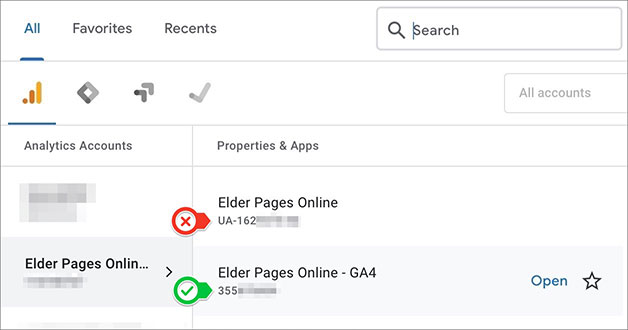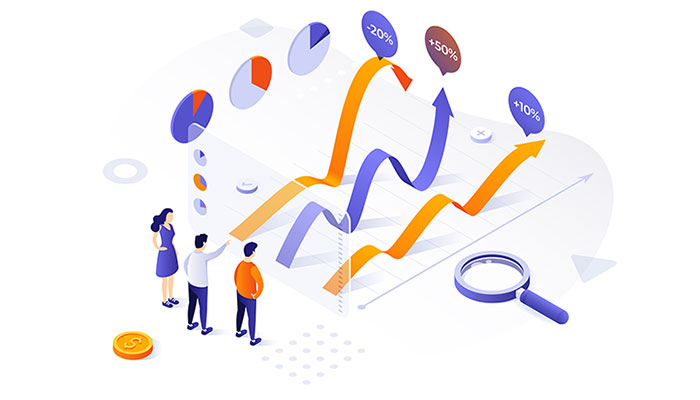
On July 1, 2023, Google is going to make a fundamental change in how it tracks traffic coming to your site. Known as “Google Analytics 4” (GA4), it will be a complete reset for everyone, replacing what has been known as “Universal Analytics” (UA) or “Google Analytics 3.” If you have not changed to GA4, Google will automatically do it for you, but you might need to adjust the settings they default to.
How to tell if you have made the switch
When you log in to Google Analytics, you will likely be viewing your old account (“property” in Google-speak) and will see big warning messages. You can “skip for now” and go to the drop-down menu in the upper right (next to the Analytics logo). Click and select the property without the “UA-..” in front of its ID number. That’s your new GA4 property.

Do you have to make the switch?
In short, yes. Google will no longer be adding data to the old UA accounts. Keep your UA account, however, because you will need it to make comparisons to previous months or years. (More about this later.)
What’s different?
From the point of view of eldercare providers (as opposed to e-commerce or large-enterprise businesses), I would say the biggest difference is that Google is shifting from measuring/reporting the sheer quantity of traffic to helping businesses hone in on the quality of their traffic.
As an example, while the number of visitors and number of sessions and time spent per page are general indicators of interest, now Google is emphasizing how people actually engage with your site, a much more reliable indicator of interest and therefore indicator of how likely a viewer is to become a client.
Possible examples of engagement
- Did a viewer actually read the full article or page (e.g., scroll to the bottom)? Previously, they just measured time spent on a page to guestimate viewer interest. But a viewer could have gotten a 10-minute phone call and never actually read the content. UA wouldn’t know the difference.
- Did a viewer fill out a contact form?
- Did a viewer download your brochure?
- Did a viewer watch your video?
- Are they a return visitor?
Events and conversions
These engagement activities are called “events.” They are all actions that move people further along the customer journey, behaviors that are precursors to signing a contract. Of course, some events are more important than others. You can assemble the “events” that you consider to be the most meaningful to track and label them “conversions.” (Classically, “conversion” means an actual sale, but people in search of eldercare do not purchase your services online, so tracking key events such as submitting a contact form is the next best thing.)
Layout of reports
The layout of the reporting is quite different, so if you were used to UA, there’s a bit of a learning curve. We’ll cover some details about this in a subsequent post.
Interesting new features
- A heavy emphasis on “real time.” What are people doing right now? Frankly, I think this is more useful for large enterprise-level e-commerce sites where there might be 100 or more visitors in a given minute. For eldercare professionals, this isn’t all that useful.
- Recent reports. It’s easy to look at things you’ve been interested in in the past.
- Insights. This uses artificial intelligence (AI) to draw your attention to changes and trends you might not have noticed (e.g., there’s been a 50 percent increase in traffic from people viewing on tablets). The shifts may or may not be relevant to actual conversions or sales.
Be forewarned
First and foremost, recognize that Google Analytics is not just a favor Google gives the world. They are trying to sell ads. There’s lots of data for that. And they will likely push you to accept alerts in the hopes that telling you something has changed—especially for the worse—might motivate you to purchase ad space or increase your “ad spend.”
They also are dealing with very large companies who have users in the thousands and from multiple countries. Or companies that are doing a lot of e-commerce. Much of the emphasis in the reports is on “monetization” (translating online activities to likely revenue) and at a scale that is much bigger than the usual in the eldercare services space.
The information overload is daunting!
In a subsequent post we’ll talk about which of these events are the most meaningful to track. Eldercare providers are their own niche, so standard advice does not necessarily apply. We’ve got you covered!
Retaining your history
With this change to GA4, it’s like a railroad changing to suddenly run on a different-gauge track. You won’t be able to easily compare data from current time to some other time period prior to July 1, 2023. It will be apples and oranges. You don’t lose your historical data. You just won’t be able to make any nifty graphs that compare visitors on July 1–31 in 2023, for instance, with visitors for the same month in 2022.

You can find similar reports (like number of new visitors and number of repeat visitors), but you’ll need to manually retrieve them from your UA account and then your GA4 account. There won’t be the same event-based reports in your UA data.
Over time, of course, you’ll start to get more “historical” data in GA4 and will be able to make those comparative graphs. In the meantime, you’ll need to make do with cobbling together manual comparisons. Google has indicated they will keep Universal Access accounts open for one year (until July 1, 2024). Then they will close down those accounts. They will not be adding new data. Just that you can go in and read your old data.
If you really, really feel you need to try to integrate your historical UA data with your contemporary new data, there will likely be apps available for this. All you need to do now is export your UA data from each report you typically track into a .csv or Excel format (see instructions).
These apps will be expensive and have a steep learning curve, and they will measure only approximate equivalents. Once you pick one, you’ll be able to upload your data from the .csv or Excel files. Again, for a large e-commerce site, it might be worth it. For eldercare providers, I doubt it’s worth the time, money, and effort.
Stay tuned for future blog posts to help you navigate the shift to GA4.
Want help with your Google presence?
Check out our Google Services

